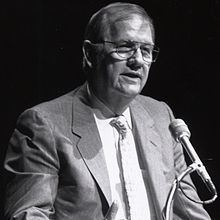Preceded by Kathryn Whitmire Name Bob Lanier Succeeded by Lee P. Brown Alma mater University of Texas | Children 7 Spouse Elyse Lanier (m. 1984) Political party Democratic Role Politician | |
 | ||
Born March 10, 1925Baytown, Texas ( 1925-03-10 ) Resting place Memorial Oaks CemeteryHouston, Texas Profession Banker, Attorney, Real Estate Developer Education University of Texas at Austin | ||
Robert Clayton Lanier (March 10, 1925 – December 20, 2014) was an American businessman and politician. He served as mayor of the city of Houston, Texas from 1992 to 1998. At the time of his death, he was Houston's oldest living mayor.
Contents
Background
Lanier was elected mayor of Houston in 1991, 1993, and 1995, until term limits, enacted in 1991 and reinforced in 1994 by a grass-roots citizen initiative spearheaded by the conservative political activist Clymer Wright, prevented his candidacy in 1997. Lanier averaged 88 percent in his re-election races, with strong support in each political party and ethnic group. As mayor, he was affectionately referred to as "Mayor Bob."
Born to working class parents in the refinery town of Baytown, Texas in 1925, Lanier was a child of the Great Depression who was greatly influenced by Franklin Delano Roosevelt’s policies. Lanier worked while attending college and started his career as a suma cum laude graduate from the University of Texas Law School in 1949. Initially employed by Baker & Botts law firm, Lanier practiced for a decade before switching gears to pursue a business career.
During that business career he worked in banking and eventually established himself as a major Houston real estate developer, focusing mostly on subdivisions and apartments.
In the 1991 Houston Mayoral election, most white voters of all economic levels voted for Lanier. His strongest tallies came from affluent neighborhoods like River Oaks, Meyerland, Uptown, Memorial and Sharpstown; in those areas he won with 60 to 65 percent or more of the vote. Lanier won 75 percent of the votes in his home Houston precinct. In racially mixed areas such as Westbury and Alief, Lanier had the majority of votes with his main opponent, Sylvester Turner, having finished in a close second place. Lanier did not win in Montrose and many African-American neighborhoods.
The Bob Lanier Public Works Building in Houston is named after him.
Political career
Before seeking his first and only elective office as Houston’s mayor in 1991, he was a gubernatorial appointee to the Texas Highway Commission, which he chaired, and chairman of METRO, Houston’s transit authority. Lanier also was a founding member of Houston Community College, which he continued to support until the end of his life.
As mayor, Lanier’s actions were guided by three core values:
Achievements
Lanier's core values were translated into specific programs once he had taken office. By the time he had left office in 1997, he had achieved the following:
The Texas NAACP presented him its Texas Hero award and he also received the Hubert Humphrey Civil Rights Award. His work in transportation earned him the National Auto Dealers' Award. His work in finance brought a Bond Market Association Award.
In 2000, he received the Leadership Houston Distinguished Service Award and the Urban Beautification Award from the American Horticultural Society. In 2002 he was inducted into the Texas Transportation Institute's Hall of Honor at Texas A&M University. In August 2007 he was also inducted into the Houston Hall of Fame.
Mayor Lanier also headed the corporation that oversaw construction of the city's new Hilton Americas – Houston, the city’s first convention center hotel – a project that started during his administration.
Until his death in 2014, Lanier continued to manage his real estate properties, lectured several times a year, oversaw the Lanier Public Policy Conferences at the University of Houston and participated in various civic, academic and political activities.
Personal life
Lanier and his wife Elyse lived in Houston, as do their seven children and 11 grandchildren.
On December 20, 2014, Lanier died at the age of 89 in Houston, Texas from natural causes.
